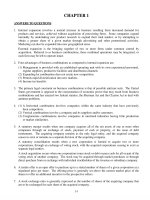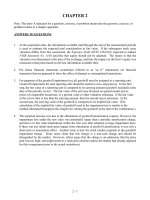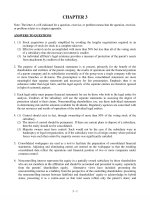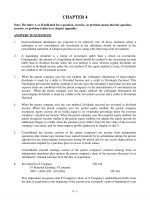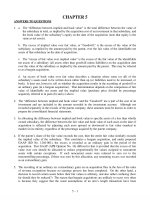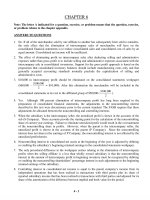Solution manual advanced accounting 4e jeter ch05
Bạn đang xem bản rút gọn của tài liệu. Xem và tải ngay bản đầy đủ của tài liệu tại đây (2.46 MB, 100 trang )
To download more slides, ebook, solutions and test bank, visit
CHAPTER 5
ANSWERS TO QUESTIONS
1. a. The ―difference between implied and book value‖ is the total difference between the value of
the subsidiary in total, as implied by the acquisition cost of an investment in that subsidiary, and
the book value of the subsidiary’s equity on the date of the acquisition (note that equity is the
same as net assets).
b. The excess of implied value over fair value, or ―Goodwill,‖ is the excess of the value of the
subsidiary, as implied by the amount paid by the parent, over the fair value of the identifiable net
assets of that subsidiary on the date of acquisition.
c. The ―excess of fair value over implied value‖ is the excess of the fair value of the identifiable
net assets of a subsidiary (all assets other than goodwill minus liabilities) on the acquisition date
over the value of the subsidiary as implied by the amount paid by the parent. This may be referred
to as a bargain acquisition.
d. An excess of book value over fair value describes a situation where some (or all) of the
subsidiary’s assets need to be written down rather than up (or liabilities need to be increased, or
both). It does not, however, tell us whether the acquisition results in the recording of goodwill or
an ordinary gain (in a bargain acquisition). That determination depends on the comparison of fair
value of identifiable net assets and the implied value (purchase price divided by percentage
acquired), referred to in parts (b) and (c) above.
2. The ―difference between implied and book value‖ and the ―Goodwill‖ are a part of the cost of an
investment and are included in the amount recorded in the investment account. Although not
recorded separately in the records of the parent company, these amounts must be known in order to
prepare the consolidated financial statements.
3. In allocating the difference between implied and book value to specific assets of a less than wholly
owned subsidiary, the difference between the fair value and book value of each asset on the date of
acquisition is reflected by adjusting each asset upward or downward to fair value (marked to
market) in its entirety, regardless of the percentage acquired by the parent company.
4. If the parent’s share of the fair value exceeds the cost, then the entire fair value similarly exceeds
the implied value of the subsidiary. This constitutes a bargain acquisition, and under proposed
GAAP (ED No. 1204-001), the excess is recorded as an ordinary gain in the period of the
acquisition. Past GAAP (APB Opinion No. 16) differed in that it provided that the excess of fair
value over cost should be allocated to reduce proportionally the values assigned to noncurrent
assets with certain exceptions. If such noncurrent assets were reduced to zero (or to the
noncontrolling percentage, if there was one) by this allocation, any remaining excess was recorded
as an extraordinary gain.
5. The recording of an ordinary (or extraordinary gain) on an acquisition flies in the face of the rules
of revenue recognition because no earnings process has been completed. On the other hand, a
decision to record certain assets below their fair values is arbitrary, and also rather confusing (how
far should they be reduced?) The reason that bargain acquisitions are unlikely to occur very often
is because they suggest that the usual assumptions of an arm’s length transaction have been
5–1
To download more slides, ebook, solutions and test bank, visit
violated. In most accounting scenarios, we assume that both parties are negotiating for a reasonable
exchange price and that price, once established, represents fair value both for the item given up and
the item received. In the case of a business combination, there is not a single item being exchanged
but rather a number of assets and liabilities. Nonetheless, the assumption is still that both parties
are negotiating for a fair valuation. If one party is able to obtain a bargain, it most likely indicates
that the other party was being influenced by non-quantitative considerations, such as a wish to retire
quickly, health concerns, etc.
6. If P Company acquires a 100 percent interest in S Company the land will be included in the
consolidated financial statements at its fair value on the date of acquisition of $1,500,000. If P
Company acquires an 80 percent interest in S Company, the land will still be included in the
consolidated financial statements at $1,500,000, and the noncontrolling interest would be charged
with its share of the fair value adjustment.
7. (d). Once the determination is made that none of the assets are over-valued (and none of the
liabilities under-valued), the bargain is reflected as an ordinary gain of $10,000 in the year of
acquisition.
8. (b). The ―excess of fair value over implied value‖ is reported as an ordinary gain under the FASB
exposure draft on business combinations (ED 1204-001).
9. Under the entity theory, the noncontrolling interest shares in the adjustment of consolidated net
assets for the difference between implied and book value. The noncontrolling interest is also
affected by the amortization or depreciation in the consolidated workpapers of the difference
between implied and book value. Assuming that implied value exceeds book value, the effect will
generally be to lower the noncontrolling interest in reported earnings because of its (the
noncontrolling interest’s) share of the excess depreciation and amortization charges, additional cost
of goods sold, impairment of goodwill, etc.
ANSWERS TO BUSINESS ETHICS CASE
This case brings an interesting question to the table for discussion. As the article by Mano points out,
each individual must decide for himself or herself how to respond to the gray issues that are bound to
arise in life. Ultimately life is more about being at peace with ourselves and leaving a legacy of a life
well-lived and values taught through our example to the generations that we leave behind us than it is
about accumulating wealth (that we cannot take to the grave). The individual, had he acted on the
advice, may have been guilty of insider trading as the information available to him was, apparently, not
available publicly. Although there is no clear-cut definition of what constitutes insider trading, the
gray area implies uncertainty; and this uncertainty can in many cases result in decisions that have
severe implications both professionally and personally.
5–2
To download more slides, ebook, solutions and test bank, visit
ANSWERS TO EXERCISES
Exercise 5-1
Part A
Computation and Allocation of Difference Schedule
Parent
Share
Purchase price and implied value
$540,000
Less: Book value of equity acquired:
Common stock
340,000
Retained earnings
119,000
Total book value
459,000
Difference between implied and book value 81,000
Marketable Securities ($45,000 – $20,000) (21,250)
Equipment ($140,000 – $120,000)
(17,000)
Balance
42,750
Goodwill
(42,750)
Balance
-0-
NonControlling
Share
95,294
60,000
21,000
81,000
14,294
(3,750)
(3,000)
7,544
(7,544)
-0-
Entire
Value
635,294 *
400,000
140,000
540,000
95,294
(25,000)
(20,000)
50,294
(50,294)
-0-
*$540,000/.85
Part B
Marketable securities
Equipment (net)
Goodwill
$ 45,000
140,000
50,294
Exercise 5-2
Computation and Allocation of Difference Schedule
Parent
Share
Purchase price and implied value
Less: Book value of equity acquired
Difference between implied and book value
Equipment ($705,000 – $525,000)
Balance
$585,000
450,000
135,000
(135,000)
-0-
NonEntire
Controlling
Value
Share
195,000
780,000 *
150,000
600,000
45,000
180,000
(45,000) (180,000)
-0-0-
*$585,000/.75
Part A Equipment
Difference between Implied and Book Value
Depreciation Expense ($180,000/10)
Accumulated Depreciation
180,000
180,000
18,000
18,000
5–3
To download more slides, ebook, solutions and test bank, visit
Exercise 5-2 (continued)
Part B
The asset has a value of $180,000 with 10 years of a 15 year life (i.e. 2/3). Therefore, the implied gross
value of the asset is $270,000 (or $180,000 2/3).
Equipment ($180,000 2/3)
Accumulated Depreciation (1/3 $270,000)
Difference between Implied and Book Value
270,000
90,000
180,000
Depreciation Expense ($180,000/10)
Accumulated Depreciation
18,000
18,000
Exercise 5-3
Part A Investment in Saddler Corporation
Cash
525,000
525,000
Part B Computation and Allocation of Difference Schedule
Parent
Share
Purchase price and implied value
$525,000
Less: Book value of equity acquired
480,000
Difference between implied and book value
45,000
Inventory
(16,000)
Marketable Securities
(20,000)
Plant and Equipment
(24,000)
Balance (excess of FV over implied value)
(15,000)
Gain
15,000
Increase Noncontrolling interest to fair value of assets
Total allocated bargain
Balance
-0*$525,000/.80
5–4
NonControlling
Share
131,250
120,000
11,250
(4,000)
(5,000)
(6,000)
(3,750)
Entire
Value
656,250 *
600,000
56,250
(20,000)
(25,000)
(30,000)
(18,750)
3,750
-0-
18,750
-0-
To download more slides, ebook, solutions and test bank, visit
Exercise 5-4
Part A
Computation and Allocation of Difference Schedule
Parent
Share
Purchase price and implied value
$260,000
Less: Book value of equity acquired
270,000
Difference between implied and book value
(10,000)
Inventory
(4,000)
Current Assets
(4,000)
Equipment (net)
(40,000)
Balance (excess of FV over implied value)
(58,000)
Gain
58,000
Increase Noncontrolling interest to fair value of assets
Total allocated bargain
Balance
-0-
NonControlling
Share
65,000
67,500
(2,500)
(1,000)
(1,000)
(10,000)
(14,500)
Entire
Value
325,000 *
337,500
(12,500)
(5,000)
(5,000)
(50,000)
(72,500)
14,500
-0-
72,500
-0-
*$260,000/.80
Part B (1) Capital Stock- Salem Company
Beginning Retained Earnings-Salem Company
Difference between Implied and Book Value
Investment in Salem Company
Noncontrolling Interest
(2) Difference between Implied and Book Value
Inventory
Current Assets
Equipment (net)
Gain on Acquisition
Noncontrolling interest
207,000
130,500
12,500
260,000
65,000
12,500
5,000
5,000
50,000
58,000
14,500
Exercise 5-5
Noncontrolling Interest in Consolidated Income
Amortization of the difference between
implied and book value related to
patent amortization ($100,000*/10)
Net income reported by S
$ 100,000
10,000
Adjusted net income of S
Noncontrolling Ownership percentage interest
Noncontrolling Interest in Consolidated Net Income
* (600,000/.80) – ($300,000 + $350,000)
5–5
90,000
20%
$ 18,000
To download more slides, ebook, solutions and test bank, visit
Exercise 5-5 (continued)
Controlling Interest in Consolidated Income
P Company's net income from its independent
operations
$ 200,000
P Company's share of the adjusted income of S
Company (.8 X $90,000)
72,000
Controlling Interest in Consolidated Net Income
Parent
Share
Purchase price and implied value
$600,000
Less: Book value of equity acquired
520,000
Difference between implied and book value (patent) 80,000
Patent
(80,000)
Balance
-0-
$ 272,000
NonEntire
Controlling
Value
Share
150,000
750,000
130,000
650,000
20,000
100,000
(20,000) (100,000)
-0-0-
*$600,000/.80
Exercise 5-6
1/1 Retained Earnings-Park Co.* (12,000 x .85)
Noncontrolling Interest
Depreciation Expense ($120,000/10)
Equipment [$120,000/(10/15)]
Accumulated Depreciation
Difference between Implied and Book Value
2012
2013
12,000
180,000
10,200
1,800
12,000
180,000
72,000a
120,000
84,000b
120,000
* If the complete equity method is used, the debit to 1/1 Retained Earnings – Park Co. would be
replaced with a debit to Investment in Sunland Company
a ($180,000)(6/15)= $72,000
b ($180,000)(7/15)= $84,000
Alternative entries
Equipment [$120,000/(10/15)]
Accumulated Depreciation ($180,000 5/15)
Difference between Implied and Book Value
1/1 Retained Earnings-Park Co*.
Noncontrolling Interest
Depreciation Expense ($120,000/10)
Accumulated Depreciation
2012
180,000
2013
180,000
60,000
120,000
60,000
120,000
10,200
1,800
12,000
12,000
12,000
* If the complete equity method is used, the debit to 1/1 Retained Earnings – Park Co. would be
replaced with a debit to Investment in Sunland Company
5–6
24,000b
To download more slides, ebook, solutions and test bank, visit
Exercise 5-7
1/1 Retained Earnings - Packard Co.*
1/1 Noncontrolling Interest
Depreciation Expense ($200,000/5)
Equipment [$200,000/(5/10)]
Accumulated Depreciation
Difference between Implied and Book Value
2011
2012
40,000
400,000
32,000
8,000
40,000
400,000
240,000a
200,000
280,000
200,000
* If the complete equity method is used, the debit to 1/1 Retained Earnings – Packard Co. would be
replaced with a debit to Investment in Sage Company
a
$400,000 (6/10) = $240,000
$400,000 (7/10) = $280,000
b
Computation and Allocation of Difference Schedule
Parent
Share
Purchase price and implied value
Less: Book value of equity acquired
Difference between implied and book value
Equipment ($705,000 – $525,000)
Balance
$600,000
440,000
160,000
(160,000)
-0-
NonEntire
Controlling
Value
Share
150,000
750,000 *
110,000
550,000
40,000
200,000
(40,000) (200,000)
-0-0-
*$600,000/.80
Alternative entries
Equipment [$200,000/(5/10)]
Accumulated Depreciation
Difference between Implied and Book Value
1/1 Retained Earnings - Packard Co.
1/1 Noncontrolling interest
Depreciation Expense ($400,000/10)
Accumulated Depreciation
2011
400,000
2012
400,000
200,000
200,000
200,000
200,000
32,000
8,000
40,000
40,000
40,000
80,000
* If the complete equity method is used, the debit to 1/1 Retained Earnings – Packard Co. would be
replaced with a debit to Investment in Sage Company
5–7
To download more slides, ebook, solutions and test bank, visit
Exercise 5-8
Part A Land ($31,000/0.8)
Difference between Implied and Book Value
38,750
38,750
Part B Gain on subsidiary books
Reduction for consolidated adjustment to fair market value
Consolidated gain
$50,000
(38,750)
$11,250
Part C 1/1 Retained Earnings - Padilla Co.
Difference between Implied and Book Value
38,750
38,750
Exercise 5-9
Part A
Computation and Allocation of Difference Schedule
Parent
Share
Purchase price and implied value
Less: Book value of equity acquired
Difference between implied and book value
Land ($100,000 – $ 80,000)
Premium on Bonds Payablea
Balance
Goodwill
Balance
$2,000,000
1,760,000
240,000
(16,000)
31,941
255,941
(255,941)
-0-
NonEntire
Controlling
Value
Share
500,000 2,500,000 *
440,000 2,200,000
60,000
300,000
(4,000)
(20,000)
7,985
39,926
63,985
319,926
(63,985) (319,926)
-0-0-
*$2,000,000/.80
a
Present Value on 1/1/2010 of 10% Bonds Payable
Discounted at 8% over 5 periods
Principal ($500,000 0.68058)
Interest ($50,000 3.99271)
Fair value of bond
Face value of bond
Bond premium
5–8
$340,290
199,636
$539,926
500,000
39,926
To download more slides, ebook, solutions and test bank, visit
Exercise 5-9 (continued)
Part B
Land
Goodwill
Interest Expense ($50,000 – ($539,926 0.08))
Unamortized Premium on Bonds Payable ($39,926 – $6,806)
Difference between Implied and Book Value
20,000
319,926
6,806
33,120
300,000
Alternative entries
Land
Goodwill
Unamortized Premium on Bonds Payable
Difference between Implied and Book Value
Unamortized Premium on Bonds Payable
Interest Expense ($50,000 – ($539,926
20,000
319,926
39,926
300,000
6,806
6,806
0.08))
Exercise 5-10
Part A
Computation and Allocation of Difference Schedule
Parent
Share
Purchase price and implied value
Less: Book value of equity acquired
Difference between implied and book value
Land ($200,000 - $ 120,000)
Premium on Bonds Payablea
Balance
Goodwill
Balance
$3,500,000
3,150,000
350,000
(72,000)
56,867
334,867
(334,867)
-0-
NonEntire
Controlling
Value
Share
388,889 3,888,889 *
350,000 3,500,000
38,889
388,889
(8,000)
(80,000)
6,319
63,186
37,208
372,075
(37,208) (372,075)
-0-0-
*$3,500,000/.90
a
Present Value on 1/2/2010 of 9% Bonds Payable
Discounted at 6% for 5 periods
Principal ($500,000 0.74726)
Interest ($45,000 4.21236)
Fair value of bond
Face value of bond
Premium on bond payable
5–9
$373,630
189,556
$563,186
500,000
63,186
To download more slides, ebook, solutions and test bank, visit
Exercise 5-10 (continued)
Part B Land
Goodwill
Interest Expense
Unamortized Premium on Bonds Payable ($63,186 – $11,209)
Difference between Implied and Book Value
a
80,000
372,075
11,209a
51,977
388,889
Year 2010
$(33,791)
45,000
11,209
Effective Interest (0.06 $563,186)
Nominal Interest (0.09 $500,000)
Difference
Alternative entries
Land
Goodwill
Unamortized Premium on Bonds Payable
Difference between Implied and Book Value
80,000
372,075
63,186
388,889
Unamortized Premium on Bonds Payable
Interest Expense
11,209
11,209a
Exercise 5-11
Part 1 – Cost Method
Computation and Allocation of Difference Schedule
Parent
Share
Purchase price and implied value
Less: Book value of equity acquired
Difference between implied and book value
Inventory
Equipment
Balance
Goodwill
Balance
$2,276,000
2,000,000
276,000
(36,000)
(40,000)
200,000
(200,000)
-0-
NonEntire
Controlling
Value
Share
569,000 2,845,000 *
500,000 2,500,000
69,000
345,000
(9,000)
(45,000)
(10,000)
(50,000)
50,000
250,000
(50,000) (250,000)
-0-0-
*$2,276,000/.80
2010
(1) Dividend Income
Dividends Declared (0.80 $20,000)
To eliminate intercompany dividends
16,000
16,000
5 – 10
To download more slides, ebook, solutions and test bank, visit
Exercise 5-11 (continued)
(2) Beginning Retained Earnings-Sand
Capital Stock-Sand
Difference between Implied and Book Value
Investment in Sand Company
Noncontrolling Interest
(3) Cost of Goods Sold (Beginning Inventory)
Depreciation Expense ($50,000/8)
Equipment (net) ($50,000 – $6,250)
Goodwill
Difference between Implied and Book Value
To allocate and depreciate the difference between implied and book value
Alternative to entry (3)
(3a) Cost of Goods Sold (Beginning Inventory)
Equipment (net)
Goodwill
Difference between Implied and Book Value
700,000
1,800,000
345,000
2,276,000
569,000
45,000
6,250
43,750
250,000
345,000
45,000
50,000
250,000
345,000
(3b) Depreciation Expense ($50,000/8)
Equipment (net)
6,250
6,250
2011
(1) Investment in Sand Company ($80,000 0.80)
Beginning Retained Earnings - Piper Company
To establish reciprocity/convert to equity method as of 1/1/2011
(2) Dividend Income ($30,000 0.80)
Dividends Declared
To eliminate intercompany dividends
64,000
64,000
24,000
24,000
(3) Beginning Retained Earnings-Sand Company ($700,000 + $100,000 – $20,000) 780,000
Capital Stock-Sand Company
1,800,000
Difference between Implied and Book Value
345,000
Investment in Sand Company ($2,276,000 + $64,000)
2,340,000
Noncontrolling Interest ($569,000 + ($780,000 – $700,000) x 0.20)
585,000
To eliminate investment account and create noncontrolling interest account
(4) Beginning Retained Earnings-Piper Company ($36,000 + $5,000)
Noncontrolling Interest ($9,000 + $1,250)
Depreciation Expense
Equipment (net) ($50,000 – $6,250 – $6,250)
Goodwill
Difference between Implied and Book Value
To allocate and depreciate the difference between implied and book value
5 – 11
41,000
10,250
6,250
37,500
250,000
345,000
To download more slides, ebook, solutions and test bank, visit
Exercise 5-11 (continued)
Alternative to entry (4)
(4a) Beginning Retained Earnings-Piper Company
Noncontrolling Interest
Equipment (net)
Goodwill
Difference between Implied and Book Value
(4b) Beginning Retained Earnings-Piper Company
Noncontrolling Interest
Depreciation Expense ($50,000/8)
Equipment (net)
2012
(1) Investment in Sand Company ($200,000 0.80)
Beginning Retained Earnings-Piper Company
To establish reciprocity/convert to equity method as of 1/1/2012
(2) Dividend Income ($15,000 0.80)
Dividends Declared
To eliminate intercompany dividends
36,000
9,000
50,000
250,000
345,000
5,000
1,250
6,250
12,500
160,000
160,000
12,000
12,000
(3) Beginning Retained Earnings-Sand ($780,000 + $150,000 – $30,000)
Common Stock- Sand Company
Difference between Implied and Book Value
Investment in Sand Company ($2,276,000 + $160,000)
Noncontrolling Interest ($569,000 + ($900,000 – $700,000) x 0.20)
To eliminate investment account and create noncontrolling interest account
(4) Beginning Retained Earnings-Piper Company ($41,000 + $5,000)
Noncontrolling Interest ($10,250 +$1,250)
Depreciation Expense
Equipment (net)
Goodwill
Difference between Implied and Book Value
To allocate and depreciate the difference between implied and book value
Alternative to entry (4)
(4a) Beginning Retained Earnings-Piper Company
Noncontrolling Interest
Equipment (net)
Goodwill
Difference between Implied and Book Value
(4b) Beginning Retained Earnings-Piper Company
Noncontrolling Interest
Depreciation Expense ($50,000/8)
Equipment (net)
5 – 12
900,000
1,800,000
345,000
2,436,000
609,000
46,000
11,500
6,250
31,250
250,000
345,000
36,000
9,000
50,000
250,000
345,000
10,000
2,500
6,250
18,750
To download more slides, ebook, solutions and test bank, visit
Exercise 5-11 (continued)
Part 2 – Partial Equity Method
Computation and Allocation of Difference Schedule
Parent
Share
Purchase price and implied value
Less: Book value of equity acquired
Difference between implied and book value
Inventory
Equipment
Balance
Goodwill
Balance
Cost of investment
$2,276,000
2,000,000
276,000
(36,000)
(40,000)
200,000
(200,000)
-0-
NonEntire
Controlling
Value
Share
569,000 2,845,000
500,000 2,500,000
69,000
345,000
(9,000)
(45,000)
(10,000)
(50,000)
50,000
250,000
(50,000) (250,000)
-0-0-
Investment in Sand Corporation (Partial Equity)
2,276,000P
2010 equity income (.8)($100,000)
Balance 2010
80,000
2,340,000
2010 Dividends (.8)($20,000)
16,000
2011 equity income (.8)($150,000)
120,000
2011 Dividends (.8)($30,000)
24,000
2012 Dividends (.8)($15,000)
12,000
Balance 2011
2012 equity income (.8)($80,000)
Balance 2012
2,436,000
64,000
2,488,000
2010
(1) Equity in Subsidiary Income (0.80 $100,000)
Dividends Declared (0.80 $20,000)
Investment in Sand Company
To eliminate intercompany dividends and income
(2) Beginning Retained Earnings-Sand
Capital Stock-Sand
Difference between Implied and Book Value
Investment in Sand Company
Noncontrolling Interest
(3) Cost of Goods Sold (Beginning Inventory)
Depreciation Expense ($50,000/8)
Equipment (net) ($50,000 – $6,250)
Goodwill
Difference between Implied and Book Value
To allocate and depreciate the difference between implied and book value
5 – 13
80,000
16,000
64,000
700,000
1,800,000
345,000
2,276,000
569,000
45,000
6,250
43,750
250,000
345,000
To download more slides, ebook, solutions and test bank, visit
Exercise 5-11 (continued)
Alternative to entry (3)
(3a) Cost of Goods Sold (Beginning Inventory)
Equipment (net)
Goodwill
Difference between Implied and Book Value
(3b) Depreciation Expense ($50,000/8)
Equipment (net)
45,000
50,000
250,000
345,000
6,250
6,250
Part 2 – Partial Equity Method
2011
(1) Equity in Subsidiary Income (0.80 $150,000)
Dividends Declared (0.80 $30,000)
Investment in Sand Company
To eliminate intercompany dividends and income
(2) Beginning Retained Earnings-Sand Company
Capital Stock- Sand Company
Difference between Implied and Book Value
Investment in Sand Company ($2,276,000 + $64,000)
Noncontrolling Interest ($569,000 + ($780,000 – $700,000) x 0.20)
To eliminate investment account and create noncontrolling interest account
(3) Beginning Retained Earnings-Piper Company ($36,000 + $5,000)
Noncontrolling Interest ($9,000 + $1,250)
Depreciation Expense
Equipment (net) ($50,000 – $6,250 – $6,250)
Goodwill
Difference between Implied and Book Value
To allocate and depreciate the difference between implied and book value
Alternative to entry (3)
(3a) Beginning Retained Earnings-Piper Company
Noncontrolling Interest
Equipment (net)
Goodwill
Difference between Implied and Book Value
(3b) Beginning Retained Earnings-Piper Company
Noncontrolling Interest
Depreciation Expense ($50,000/8)
Equipment (net)
5 – 14
120,000
24,000
96,000
780,000
1,800,000
345,000
2,340,000
585,000
41,000
10,250
6,250
37,500
250,000
345,000
36,000
9,000
50,000
250,000
345,000
5,000
1,250
6,250
12,500
To download more slides, ebook, solutions and test bank, visit
Exercise 5-11 (continued)
2012
(1) Equity in Subsidiary Income (0.80 $80,000)
Dividends Declared (0.80 $15,000)
Investment in Sand Company
To eliminate intercompany dividends and income
64,000
12,000
52,000
Part 2 – Partial Equity Method
(2) Beginning Retained Earnings-Sand
Common Stock- Sand Company
Difference between Implied and Book Value
Investment in Sand Company ($2,276,000 + $160,000)
Noncontrolling Interest ($569,000 + ($900,000 – $700,000) x 0.20)
To eliminate investment account and create noncontrolling interest account
(3) Beginning Retained Earnings-Piper Company ($41,000 + $5,000)
Noncontrolling Interest ($10,250 + $1,250)
Depreciation Expense
Equipment (net)
Goodwill
Difference between Implied and Book Value
To allocate and depreciate the difference between implied and book value
Alternative to entry (3)
(3a) Beginning Retained Earnings-Piper Company
Noncontrolling Interest
Equipment (net)
Goodwill
Difference between Implied and Book Value
(3b) Beginning Retained Earnings-Piper Company
Noncontrolling Interest
Depreciation Expense ($50,000/8)
Equipment (net)
5 – 15
900,000
1,800,000
345,000
2,436,000
609,000
46,000
11,500
6,250
31,250
250,000
345,000
36,000
9,000
50,000
250,000
345,000
10,000
2,500
6,250
18,750
To download more slides, ebook, solutions and test bank, visit
Exercise 5-11 (Continued)
Part 3 – Complete Equity Method
Computation and Allocation of Difference Schedule
Parent
Share
Purchase price and implied value
Less: Book value of equity acquired
Difference between implied and book value
Inventory
Equipment
Balance
Goodwill
Balance
Cost of investment
Investment in Sand Corporation (Complete Equity)
2,276,000 P
2010 equity income (.8)($100,000)
Balance 2010
2011 equity income (.8)($150,000)
Balance 2011
2012 equity income (.8)($80,000)
Balance 2012
$2,276,000
2,000,000
276,000
(36,000)
(40,000)
200,000
(200,000)
-0-
NonEntire
Controlling
Value
Share
569,000 2,845,000
500,000 2,500,000
69,000
345,000
(9,000)
(45,000)
(10,000)
(50,000)
50,000
250,000
(50,000) (250,000)
-0-0-
80,000
2010 Dividends (.8)($20,000)
2010 depreciation
and cost of goods sold
16,000
2011 Dividends (.8)($30,000)
2011 depreciation
and cost of goods sold
24,000
2012 Dividends (.8)($15,000)
2012 depreciation
and cost of goods sold
12,000
41,000
2,299,000
120,000
5,000
2,390,000
64,000
5,000
2,437,000
2010
(1) Equity in Subsidiary Income ((0.80 $100,000) – $51,000)
Dividends Declared (0.80 $20,000)
Investment in Sand Company
To eliminate intercompany dividends and income
(2) Beginning Retained Earnings-Sand
Capital Stock- Sand
Difference between Implied and Book Value
Investment in Sand Company
Noncontrolling Interest
5 – 16
29,000
16,000
13,000
700,000
1,800,000
345,000
2,276,000
569,000
To download more slides, ebook, solutions and test bank, visit
Exercise 5-11 (continued)
(3) Cost of Goods Sold (Beginning Inventory)
Depreciation Expense ($50,000/8)
Equipment (net) ($50,000 – $6,250)
Goodwill
Difference between Implied and Book Value
To allocate and depreciate the difference between implied and book value
45,000
6,250
43,750
250,000
345,000
Part 3 – Complete Equity Method
Alternative to entry (3)
(3a) Cost of Goods Sold (Beginning Inventory)
Equipment (net)
Goodwill
Difference between Implied and Book Value
(3b) Depreciation Expense ($50,000/8)
Equipment (net)
45,000
50,000
250,000
345,000
6,250
6,250
2011
(1) Equity in Subsidiary Income ((0.80 $150,000) – $15,000)
Dividends Declared (0.80 $30,000)
Investment in Sand Company
To eliminate intercompany dividends and income
(2) Beginning Retained Earnings-Sand Company
Capital Stock- Sand Company
Difference between Implied and Book Value
Investment in Sand Company ($2,276,000 + $64,000)
Noncontrolling Interest ($569,000 + ($780,000 – $700,000) x 0.20)
To eliminate investment account and create noncontrolling interest account
(3) Investment in Sand Company ($36,000 + $5,000)
Noncontrolling interest ($9,000 + $1,250)
Depreciation expense
Equipment (net) ($50,000 – $6,250 – $6,250)
Goodwill
Difference between Implied and Book Value
To allocate and depreciate the difference between implied and book value
Alternative to entry (4)
(3a) Investment in Sand Company
Noncontrolling Interest
Equipment (net)
Goodwill
Difference between Implied and Book Value
5 – 17
105,000
24,000
81,000
780,000
1,800,000
345,000
2,340,000
585,000
41,000
10,250
6,250
37,500
250,000
345,000
36,000
9,000
50,000
250,000
345,000
To download more slides, ebook, solutions and test bank, visit
Exercise 5-11 (continued)
(3b) Investment in Sand Company
Noncontrolling interest
Depreciation Expense ($50,000/8)
Equipment (net)
5,000
1,250
6,250
12,500
Part 3 – Complete Equity Method
2012
(1) Equity in Subsidiary Income ((0.80 $80,000) – $15,000)
Dividends Declared (0.80 $15,000)
Investment in Sand Company
To eliminate intercompany dividends and income
(2) Beginning Retained Earnings-Sand
Common Stock- Sand Company
Difference between Implied and Book Value
Investment in Sand Company ($2,276,000 + $160,000)
Noncontrolling Interest ($569,000 + ($900,000 – $700,000) x 0.20)
To eliminate investment account and create noncontrolling interest account
(3) Investment in Sand Company ($41,000 + $5,000)
Noncontrolling Interest ($10,250 + $1,250)
Depreciation Expense
Equipment (net)
Goodwill
Difference between Implied and Book Value
To allocate and depreciate the difference between implied and book value
Alternative to entry (3)
(3a) Investment in Sand Company
Noncontrolling Interest
Equipment (net)
Goodwill
Difference between Implied and Book Value
(3b) Investment in Sand Company
Noncontrolling Interest
Depreciation Expense ($50,000/8)
Equipment (net)
49,000
12,000
37,000
900,000
1,800,000
345,000
2,436,000
609,000
46,000
11,500
6,250
31,250
250,000
345,000
36,000
9,000
50,000
250,000
345,000
10,000
2,500
6,250
18,750
5 – 18
To download more slides, ebook, solutions and test bank, visit
Exercise 5-12
Part A (1) Investment in Saxton Corporation
Beginning Retained Earnings-Palm Inc.
To establish reciprocity/convert to equity (0.90
225,000
225,000
($1,250,000 – $1,000,000))
Computation and Allocation of Difference Schedule
Parent
Share
Purchase price and implied value
$3,750,000
Less: Book value of equity acquired
3,600,000
Difference between implied and book value
150,000
Inventory
(90,000)
Land
(360,000)
Balance (excess of FV over implied value)
(300,000)
Gain
300,000
Increase Noncontrolling interest to fair value of assets
Total allocated bargain
Balance
-0-
NonControlling
Share
416,667
400,000
16,667
(10,000)
(40,000)
(33,333)
Entire
Value
4,166,667 *
4,000,000
166,667
(100,000)
(400,000)
(333,333)
33,333
-0-
333,333
-0-
*$3,750,000/.90
(2) Beginning Retained Earnings-Saxton Co.
1,250,000
Capital Stock- Saxton Co.
3,000,000
Difference between Implied and Book Value
166,667
Investment in Saxton Co. ($3,750,000 + $225,000)
3,975,000
Noncontrolling Interest [$416,667 + ($1,250,000 – $1,000,000) x .10]
441,667
To eliminate the investment amount and create noncontrolling interest account
(3) Beginning Retained Earnings-Palm Inc.
Noncontrolling Interest
Land
Difference between Implied and Book Value
Gain on Acquisition
Noncontrolling Interest
To allocate and depreciate the difference between implied and book value
5 – 19
90,000
10,000
400,000
166,667
300,000
33,333
To download more slides, ebook, solutions and test bank, visit
Exercise 5-12 (continued)
Part B Palm Incorporated's Retained Earnings on 12/31/2012
Palm Incorporated's share of the increase in Saxton Corporation's Retained
Earnings from acquisition date to 12/31/2012 ($1,550,000 - $1,000,000) 0.9
Less the cumulative effect to 12/31/2012 of the amortization of the difference
between implied and book value
2011
2012
Current Assets (inventory)
$90,000
$0
Gain
(300,000)
(0)
Total
$(210,000)
$(0)
Consolidated Retained Earnings on 12/31/2012
$2,000,000
495,000
210,000
$2,705,000
Exercise 5-13
Imputed Value ($2,070,000/0.9)
Recorded Value ($1,200,000 + $600,000)
Unrecorded Values
Allocated to identifiable assets
Inventory ($725,000 - $600,000)
Equipment ($1,075,000 - $900,000)
Net Assets
$2,300,000
1,800,000
$500,000
$125,000
175,000
300,000
Goodwill
$200,000
Inventory
Equipment
Goodwill
Revaluation Capital
125,000
175,000
200,000
500,000
5 – 20
To download more slides, ebook, solutions and test bank, visit
Exercise 5-14
Part A
Computation and Allocation of Difference Schedule
Parent
Share
Purchase price and implied value
$3,750,000
Less: Book value of equity acquired
3,600,000
Difference between implied and book value
150,000
Inventory
(90,000)
Land
(360,000)
Balance (excess of FV over implied value)
(300,000)
Gain
300,000
Increase Noncontrolling interest to fair value of assets
Total allocated bargain
Balance
-0-
NonControlling
Share
416,667
400,000
16,667
(10,000)
(40,000)
(33,333)
Entire
Value
4,166,667 *
4,000,000
166,667
(100,000)
(400,000)
(333,333)
33,333
-0-
333,333
-0-
*$3,750,000/.90
Cost of investment
Investment in Saxton Corporation (Partial Equity)
3,750,000 P
2011 equity income (.9)($250,000)
Balance 2011
225,000
3,975,000
2011 Dividends
0
2012 equity income (.9)($300,000)
270,000
2012 Dividends
0
Balance 2012
4,245,000
(1) Equity in Subsidiary Income
Investment in Saxton Corporation.
To eliminate subsidiary income ($270,000)
270,000
270,000
(2) Beginning Retained Earnings-Saxton Co.
1,250,000
Capital Stock- Saxton Co
3,000,000
Difference between Implied and Book Value
166,667
Investment in Saxton Co. ($3,750,000 + $225,000)
3,975,000
Noncontrolling Interest $416,667 + [($1,250,000 – $1,000,000) x .10]
441,667
To eliminate the investment amount and create noncontrolling interest account
(3) Beginning Retained Earnings-Palm Inc.
90,000
Noncontrolling Interest
10,000
Land
400,000
Difference between Implied and Book Value
Gain on Acquisition
Noncontrolling Interest
To allocate and depreciate the difference between implied and book value
5 – 21
166,667
300,000
33,333
To download more slides, ebook, solutions and test bank, visit
Exercise 5-14 (continued)
Part B Palm Incorporated's Retained Earnings on 12/31/2012
Less the cumulative effect to 12/31/2012 of the amortization of the difference
between implied and book value
2011
2012
Current Assets (inventory)
$90,000
$0
Gain
(300,000)
(0)
Total
$(210,000)
$(0)
Consolidated Retained Earnings on 12/31/2012
$2,495,000
210,000
$2,705,000
Exercise 5-15
Part A
Computation and Allocation of Difference Schedule
Parent
Share
Purchase price and implied value
$3,750,000
Less: Book value of equity acquired
3,600,000
Difference between implied and book value
150,000
Inventory
(90,000)
Land
(360,000)
Balance (excess of FV over implied value)
(300,000)
Gain
300,000
Increase Noncontrolling interest to fair value of assets
Total allocated bargain
Balance
-0-
NonControlling
Share
416,667
400,000
16,667
(10,000)
(40,000)
(33,333)
Entire
Value
4,166,667 *
4,000,000
166,667
(100,000)
(400,000)
(333,333)
33,333
-0-
333,333
-0-
*$3,750,000/.90
Cost of investment
2011 equity income (.9)($250,000)
Balance 2011
2012 equity income (.9)($300,000)
Balance 2012
Investment in Saxton Corporation
3,750,000 P
225,000
2011 Dividends
2011 amortization (equity income)
0
75,000
2012 Dividends
2012 amortization (equity income)
0
15,000
3,900,000
270,000
4,155,000
5 – 22
To download more slides, ebook, solutions and test bank, visit
Exercise 5-15 (continued)
(1) Equity in Subsidiary Income
Investment in Saxton Corporation.
To eliminate subsidiary income ((.90)($300,000) - $15,000)
255,000
255,000
(2) Beginning Retained Earnings-Saxton Co.
1,250,000
Capital Stock- Saxton Co.
3,000,000
Difference between Implied and Book Value
166,667
Investment in Saxton Co.
3,975,000
Noncontrolling Interest [$416,667 + ($1,250,000 – 1,000,000) x .10]
441,667
To eliminate the investment amount and create noncontrolling interest account
(3) Investment in Saxton Co.
Noncontrolling Interest
Land
Difference between Implied and Book Value
Beginning Retained Earnings-P (gain on acquisition)
Noncontrolling Interest
To allocate and depreciate the difference between implied and book value
90,000
10,000
400,000
166,667
300,000
33,333
Part B Palm Incorporated's Retained Earnings on 12/31/2012
Consolidated Retained Earnings on 12/31/2012
$2,705,000
$2,705,000
Under the complete equity method, Palm’s retained earnings will equal consolidated retained
earnings.
Exercise 5-16
Part A.
2011: Step 1: Fair value of the reporting unit
Carrying value of unit:
Carrying value of identifiable net assets
Carrying value of goodwill ($450,000 - $375,000)
$400,000
$330,000
75,000
Excess of carrying value over fair value
405,000
$ 5,000
The excess of carrying value over fair value means that step 2 is required.
Step 2: Fair value of the reporting unit
Fair value of identifiable net assets
Implied value of goodwill
Recorded value of goodwill ($450,000 - $375,000)
Impairment loss
5 – 23
$400,000
340,000
60,000
75,000
$ 15,000
To download more slides, ebook, solutions and test bank, visit
Exercise 5-16 (continued)
2012: Step 1: Fair value of the reporting unit
Carrying value of unit:
Carrying value of identifiable net assets
Carrying value of goodwill ($75,000 - $15,000)
$400,000
$320,000
60,000
380,000
$ 20,000
Excess of fair value over carrying value
The excess of fair value over carrying value means that step 2 is not required.
2013: Step 1: Fair value of the reporting unit
Carrying value of unit:
Carrying value of identifiable net assets
Carrying value of goodwill ($75,000 - $15,000)
$350,000
$300,000
60,000
360,000
$ 10,000
Excess of carrying value over fair value
The excess of carrying value over fair value means that step 2 is required.
Step 2: Fair value of the reporting unit
Fair value of identifiable net assets
Implied value of goodwill
Recorded value of goodwill ($75,000 - $15,000)
Impairment loss
Part B.
1. 2011: Impairment Loss—Goodwill
Goodwill
$350,000
325,000
25,000
60,000
$ 35,000
15,000
15,000
2012: Retained Earnings-Porsche
Goodwill
15,000
2013: Impairment Loss—Goodwill
Retained Earnings – Porsche
Goodwill
35,000
15,000
2. 2011: Impairment Loss—Goodwill
Goodwill
15,000
15,000
50,000
15,000
2012: Investment in Saab
Goodwill
15,000
2013: Impairment Loss—Goodwill
Investment in Saab
Goodwill
35,000
15,000
15,000
50,000
5 – 24
To download more slides, ebook, solutions and test bank, visit
ANSWERS TO PROBLEMS
Problem 5-1
Calculations:
Computation and Allocation of Difference Schedule
Parent
Share
Purchase price and implied value
Less: Book value of equity acquired
Difference between implied and book value
Equipment (net) ($1,500,000 - $600,000
Balance
Goodwill
Balance
$2,800,000
1,200,000
1,600,000
(720,000)
880,000
(880,000)
-0-
NonEntire
Controlling
Value
Share
700,000 3,500,000 *
300,000 1,500,000
400,000 2,000,000
(180,000) (900,000)
220,000 1,100,000
(220,000) (1,100,000)
-0-0-
*$2,800,000/.80
Depreciation of difference allocated to Palmero ($720,000/10)
Depreciation of difference allocated to Santos ($180,000/10)
$72,000
$18,000
Part A 2011
(1) Beginning Retained Earnings-Santos Co.
1,000,000
Capital Stock- Santos Co.
500,000
Difference between Implied and Book Value
2,000,000
Investment in Santos Co.
2,800,000
Noncontrolling Interest
700,000
To eliminate investment account and create noncontrolling interest account
(2) Depreciation Expense
90,000
Property and Equipment (net) ($900,000 - $90,000)
810,000
Goodwill
1,100,000
Difference between Implied and Book Value
2,000,000
To allocate and depreciate the difference between implied and book value
Alternative to entry (2)
(2a)
Property and Equipment (net)
Goodwill
Difference between Implied and Book Value
(2b) Depreciation Expense
Property and Equipment (net)
900,000
1,100,000
2,000,000
90,000
90,000
5 – 25



